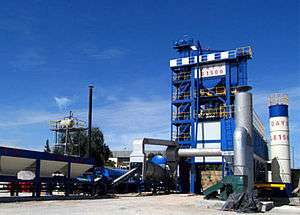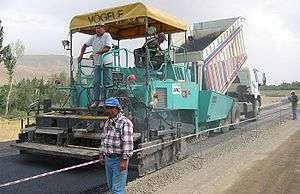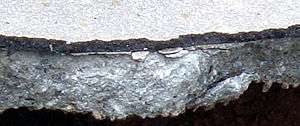Asphalt concrete
Asphalt concrete (commonly called asphalt,[1] blacktop, or pavement in North America, and tarmac, bitumen macadam, or rolled asphalt in the United Kingdom and the Republic of Ireland) is a composite material commonly used to surface roads, parking lots, airports, and the core of embankment dams.[2] Asphalt mixtures have been used in pavement construction since the beginning of the twentieth century.[3] It consists of mineral aggregate bound together with asphalt, laid in layers, and compacted. The process was refined and enhanced by Belgian inventor and U.S. immigrant Edward De Smedt.[4]


The terms asphalt (or asphaltic) concrete, bituminous asphalt concrete, and bituminous mixture are typically used only in engineering and construction documents, which define concrete as any composite material composed of mineral aggregate adhered with a binder. The abbreviation, AC, is sometimes used for asphalt concrete but can also denote asphalt content or asphalt cement, referring to the liquid asphalt portion of the composite material.
Mixture formulations

Mixing of asphalt and aggregate is accomplished in one of several ways:[5]
- Hot-mix asphalt concrete (commonly abbreviated as HMA)
- This is produced by heating the asphalt binder to decrease its viscosity, and drying the aggregate to remove moisture from it prior to mixing. Mixing is generally performed with the aggregate at about 300 °F (roughly 150 °C) for virgin asphalt and 330 °F (166 °C) for polymer modified asphalt, and the asphalt cement at 200 °F (95 °C). Paving and compaction must be performed while the asphalt is sufficiently hot. In many countries paving is restricted to summer months because in winter the compacted base will cool the asphalt too much before it is able to be packed to the required density. HMA is the form of asphalt concrete most commonly used on high traffic pavements such as those on major highways, racetracks and airfields. It is also used as an environmental liner for landfills, reservoirs, and fish hatchery ponds.[6]
- Warm-mix asphalt concrete (commonly abbreviated as WMA)
- This is produced by adding either zeolites, waxes, asphalt emulsions, or sometimes even water to the asphalt binder prior to mixing. This allows significantly lower mixing and laying temperatures and results in lower consumption of fossil fuels, thus releasing less carbon dioxide, aerosols and vapors. Not only are working conditions improved, but the lower laying-temperature also leads to more rapid availability of the surface for use, which is important for construction sites with critical time schedules. The usage of these additives in hot mixed asphalt (above) may afford easier compaction and allow cold weather paving or longer hauls. Use of warm mix is rapidly expanding. A survey of US asphalt producers found that nearly 25% of asphalt produced in 2012 was warm mix, a 416% increase since 2009.[7] Warm mix asphalt represents a concrete opportunity to create, develop, and implement a cleaner pavement process which leads to a significant decrease of pollutants and greenhouse gas emissions.[8]
- Cold-mix asphalt concrete
- This is produced by emulsifying the asphalt in water with an emulsifying agent prior to mixing with the aggregate. While in its emulsified state, the asphalt is less viscous and the mixture is easy to work and compact. The emulsion will break after enough water evaporates and the cold mix will, ideally, take on the properties of an HMA pavement. Cold mix is commonly used as a patching material and on lesser trafficked service roads.
- Cut-back asphalt concrete
- Is a form of cold mix asphalt produced by dissolving the binder in kerosene or another lighter fraction of petroleum prior to mixing with the aggregate. While in its dissolved state, the asphalt is less viscous and the mix is easy to work and compact. After the mix is laid down the lighter fraction evaporates. Because of concerns with pollution from the volatile organic compounds in the lighter fraction, cut-back asphalt has been largely replaced by asphalt emulsion.[9]
- Mastic asphalt concrete, or sheet asphalt
- This is produced by heating hard grade blown bitumen (i.e., partly oxidised) in a green cooker (mixer) until it has become a viscous liquid after which the aggregate mix is then added. The bitumen aggregate mixture is cooked (matured) for around 6–8 hours and once it is ready, the mastic asphalt mixer is transported to the work site where experienced layers empty the mixer and either machine or hand lay the mastic asphalt contents on to the road. Mastic asphalt concrete is generally laid to a thickness of around 3⁄4–1 3⁄16 inches (20–30 mm) for footpath and road applications and around 3⁄8 of an inch (10 mm) for flooring or roof applications.
- High-modulus asphalt concrete, sometimes referred to by the French-language acronym EMÉ (enrobé à module élevé)
- This uses a very hard bituminous formulation (penetration 10/20), sometimes modified, in proportions close to 6% by weight of the aggregates, as well as a high proportion of mineral powder (between 8–10%) to create an asphalt concrete layer with a high modulus of elasticity (of the order of 13000 MPa). This makes it possible to reduce the thickness of the base layer up to 25% (depending on the temperature) in relation to conventional bitumen,[10] while offering as very high fatigue strengths.[11] High-modulus asphalt layers are used both in reinforcement operations and in the construction of new reinforcements for medium and heavy traffic. In base layers, they tend to exhibit a greater capacity of absorbing tensions and, in general, better fatigue resistance.[12]
In addition to the asphalt and aggregate, additives, such as polymers, and antistripping agents may be added to improve the properties of the final product.
Areas paved with asphalt concrete—especially airport aprons—have been called "the tarmac" at times, despite not being constructed using the tarmacadam process.[13]
A variety of specialty asphalt concrete mixtures have been developed to meet specific needs, such as stone-matrix asphalt, which is designed to ensure a very strong wearing surface, or porous asphalt pavements, which are permeable and allow water to drain through the pavement for controlling stormwater.
Performance characteristics

Different types of asphalt concrete have different performance characteristics in terms of surface durability, tire wear, braking efficiency and roadway noise. In principle, the determination of appropriate asphalt performance characteristics must take into account the volume of traffic in each vehicle category, and the performance requirements of the friction course.
Asphalt concrete generates less roadway noise than a Portland cement concrete surface, and is typically less noisy than chip seal surfaces.[14][15] Because tire noise is generated through the conversion of kinetic energy to sound waves, more noise is produced as the speed of a vehicle increases. The notion that highway design might take into account acoustical engineering considerations, including the selection of the type of surface paving, arose in the early 1970s.[14][15]
With regard to structural performance, the asphalt behaviour depends on a variety of factors including the material, loading and environmental condition. Furthermore, the performance of pavement varies over time. Therefore, the long-term behaviour of asphalt pavement is different from its short-term performance. The LTPP is a research program by the FHWA, which is specifically focusing on long-term pavement behaviour.[16][17]
Degradation and restoration
Asphalt deterioration can include crocodile cracking, potholes, upheaval, raveling, bleeding, rutting, shoving, stripping, and grade depressions. In cold climates, frost heaves can crack asphalt even in one winter. Filling the cracks with bitumen is a temporary fix, but only proper compaction and drainage can slow this process.
Factors that cause asphalt concrete to deteriorate over time mostly fall into one of three categories: construction quality, environmental considerations, and traffic loads. Often, damage results from combinations of factors in all three categories.
Construction quality is critical to pavement performance. This includes the construction of utility trenches and appurtenances that are placed in the pavement after construction. Lack of compaction in the surface of the asphalt, especially on the longitudinal joint can reduce the life of a pavement by 30 to 40%. Service trenches in pavements after construction have been said to reduce the life of the pavement by 50%, mainly due to the lack of compaction in the trench, and also because of water intrusion through improperly sealed joints.
Environmental factors include heat and cold, the presence of water in the subbase or subgrade soil underlying the pavement, and frost heaves.
High temperatures soften the asphalt binder, allowing heavy tire loads to deform the pavement into ruts. Paradoxically, high heat and strong sunlight also cause the asphalt to oxidize, becoming stiffer and less resilient, leading to crack formation. Cold temperatures can cause cracks as the asphalt contracts. Cold asphalt is also less resilient and more vulnerable to cracking.
Water trapped under the pavement softens the subbase and subgrade, making the road more vulnerable to traffic loads. Water under the road freezes and expands in cold weather, causing and enlarging cracks. In spring thaw, the ground thaws from the top down, so water is trapped between the pavement above and the still-frozen soil underneath. This layer of saturated soil provides little support for the road above, leading to the formation of potholes. This is more of a problem for silty or clay soils than sandy or gravelly soils. Some jurisdictions pass frost laws to reduce the allowable weight of trucks during the spring thaw season and protect their roads.
The damage a vehicle causes is roughly proportional to the axle load raised to the fourth power, so doubling the weight an axle carries actually causes 16 times as much damage.[18] Wheels cause the road to flex slightly, resulting in fatigue cracking, which often leads to crocodile cracking. Vehicle speed also plays a role. Slowly moving vehicles stress the road over a longer period of time, increasing ruts, cracking, and corrugations in the asphalt pavement.
Other causes of damage include heat damage from vehicle fires, or solvent action from chemical spills.
Prevention and repair of degradation
The life of a road can be prolonged through good design, construction and maintenance practices. During design, engineers measure the traffic on a road, paying special attention to the number and types of trucks. They also evaluate the subsoil to see how much load it can withstand. The pavement and subbase thicknesses are designed to withstand the wheel loads. Sometimes, geogrids are used to reinforce the subbase and further strengthen the roads. Drainage, including ditches, storm drains and underdrains are used to remove water from the roadbed, preventing it from weakening the subbase and subsoil.
Good maintenance practices center on keeping water out of the pavement, subbase and subsoil. Maintaining and cleaning ditches and storm drains will extend the life of the road at low cost. Sealing small cracks with bituminous crack sealer prevents water from enlarging cracks through frost weathering, or percolating down to the subbase and softening it.
For somewhat more distressed roads, a chip seal or similar surface treatment may be applied. As the number, width and length of cracks increases, more intensive repairs are needed. In order of generally increasing expense, these include thin asphalt overlays, multicourse overlays, grinding off the top course and overlaying, in-place recycling, or full-depth reconstruction of the roadway.
It is far less expensive to keep a road in good condition than it is to repair it once it has deteriorated. This is why some agencies place the priority on preventive maintenance of roads in good condition, rather than reconstructing roads in poor condition. Poor roads are upgraded as resources and budget allow. In terms of lifetime cost and long term pavement conditions, this will result in better system performance. Agencies that concentrate on restoring their bad roads often find that by the time they have repaired them all, the roads that were in good condition have deteriorated.[19]
Some agencies use a pavement management system to help prioritize maintenance and repairs.
Recycling
Asphalt concrete is 100% recyclable and is the most widely reused construction material in the world. Very little asphalt concrete — less than 1 percent, according to a survey by the US Federal Highway Administration and the National Asphalt Pavement Association conducted annually since 2009 — is actually disposed of in landfills.[20] When asphalt pavement material is reclaimed for reuse, it is able to replace both virgin aggregates and virgin asphalt binder. In 2018, new asphalt pavement mixtures produced in the United States contained, on average, more than 21% reclaimed asphalt pavement.[20]
There is asphalt recycling on a large scale (known as in-place asphalt recycling or asphalt recycling performed at a hot mix plant) and asphalt recycling on a smaller scale. For small scale asphalt recycling, the user separates asphalt material into three different categories:
- Blacktop cookies
- Chunks of virgin uncompacted hot mix asphalt which can be used for pothole repair. The use of blacktop cookies has been investigated as a less expensive, less labor-intensive, more durable alternative to repairing potholes with cold patch. In a program in Pittsfield, Massachusetts, workers purchased new hot mix asphalt and spread it liberally on the ground to produce approximately 25 lb. wafers. Once cooled, the wafers could be stored until reheated in a hotbox to make minor road repairs. Blacktop cookies may also be produced from leftover material from paving jobs.[21]
- Reclaimed asphalt pavement (RAP)
- Chunks of asphalt that have been removed from a road, parking lot or driveway are considered reclaimed asphalt pavement (RAP). These chunks of asphalt typically are ripped up when making a routine asphalt repair, man hole repair, catch basin repair or sewer main repair. Because the asphalt has been compacted, RAP is a denser asphalt material and typically takes longer to recycle than blacktop cookies.
- Asphalt millings
- Small pieces of asphalt produced by mechanically grinding asphalt surfaces are referred to as asphalt millings. Large millings that have a rich, black tint indicating a high asphalt cement content are best for asphalt recycling purposes. Surface millings are recommended over full depth millings when choosing asphalt millings to recycle. Full depth millings usually contain sub-base contaminants such as gravel, mud and sand. These sub base contaminants will leach oil away from original asphalt and dry out the material in the recycling process. Asphalt milled from asphalt is better than asphalt milled from concrete. When milling asphalt from concrete the dust that is created is not compatible with asphalt products because it is not asphalt.[22]
Small scale asphalt recycling will usually involve high speed on-site asphalt recycling equipment or overnight soft heat asphalt recycling.
Small scale asphalt recycling is used when wanting to make smaller road repairs vs. large scale asphalt recycling which is done for making new asphalt or for tearing up old asphalt and simultaneously recycling or replacing existing asphalt. Recycled asphalt is very effective for pothole and utility cut repairs. The recycled asphalt will generally last as long or longer than the road around it as new asphalt cement has been added back to the material.[23]
For larger scale asphalt recycling, several in-place recycling techniques have been developed to rejuvenate oxidized binders and remove cracking, although the recycled material is generally not very water-tight or smooth and should be overlaid with a new layer of asphalt concrete. Cold in-place recycling mills off the top layers of asphalt concrete and mixes the resulting loose millings with asphalt emulsion. The mixture is then placed back down on the roadway and compacted. The water in the emulsion is allowed to evaporate for a week or so, and new hot-mix asphalt is laid on top.
Asphalt concrete that is removed from a pavement is usually stockpiled for later use as aggregate for new hot mix asphalt at an asphalt plant. This reclaimed material, or RAP, is crushed to a consistent gradation and added to the HMA mixing process. Sometimes waste materials, such as asphalt roofing shingles, crushed glass, or rubber from old tires, are added to asphalt concrete as is the case with rubberized asphalt, but there is a concern that the hybrid material may not be recyclable.
References
- The American Heritage Dictionary of the English Language. Boston: Houghton Mifflin Harcourt. 2011. p. 106. ISBN 978-0-547-04101-8.
- "Asphalt concrete cores for embankment dams". International Water Power and Dam Construction. Archived from the original on 7 July 2012. Retrieved 3 April 2011.
- Polaczyk, Pawel; Huang, Baoshan; Shu, Xiang; Gong, Hongren (September 2019). "Investigation into Locking Point of Asphalt Mixtures Utilizing Superpave and Marshall Compactors". Journal of Materials in Civil Engineering. 31 (9): 04019188. doi:10.1061/(ASCE)MT.1943-5533.0002839.
- Reid, Carlton (2015). Roads Were Not Built for Cars: How Cyclists Were the First to Push for Good Roads & Became the Pioneers of Motoring. Island Press. p. 120. ISBN 9781610916899.
- "Asphalt Pavement Technologies". Asphalt Pavement Alliance. Retrieved 2014-09-13.
- "Asphalt for Environmental Liners (PS 17)" (PDF). National Asphalt Pavement Association. 1984-11-15. Retrieved 2014-09-13.
- "Survey finds growth in recycled materials for asphalt". Construction Demolition Recycling. February 5, 2014. Archived from the original on 2014-02-23.
- Cheraghian, Goshtasp; Cannone Falchetto, Augusto; You, Zhanping; Chen, Siyu; Kim, Yun Su; Westerhoff, Jan; Moon, Ki Hoon; Wistuba, Michael P. (18 May 2020). "Warm mix asphalt technology: An up to date review". Journal of Cleaner Production: 122128. doi:10.1016/j.jclepro.2020.122128.
- Asphalt Paving Principles (PDF). Cornell Local Roads Program. 2003.
- Espersson, Maria (November 2014). "Effect in the high modulus asphalt concrete with the temperature". Construction and Building Materials. 71: 638–643. doi:10.1016/j.conbuildmat.2014.08.088.
- Jones, Jason; Bryant, Peter (March 2015). High Modulus Asphalt (EME2) Pavement Design (Technical Note 142) (PDF). Fortitude Valley, Queensland, Australia: State of Queensland (Australia) Department of Transport and Main Roads. Archived from the original (PDF) on 2016-12-21. Retrieved 2016-12-20.
- Balkema, AA; Choi, YK; Collop, AC; Airey, GD. Assessment of Durability of High Modulus Base (HMB) Materials. 6th International Conference on the Bearing Capacity of Roads and Airfields. ISBN 90-5809-398-0.
- Valdes, Fred (2009-08-21). Tarmac. Xlibris Corporation. ISBN 9781465322425.
- John Shadely, Acoustical analysis of the New Jersey Turnpike widening project between Raritan and East Brunswick, Bolt Beranek and Newman, 1973
- Hogan, C. Michael (September 1973). "Analysis of highway noise". Water, Air, and Soil Pollution. 2 (3): 387–392. Bibcode:1973WASP....2..387H. doi:10.1007/BF00159677.
- "Federal Highway Administration Research and Technology Coordinating, Developing, and Delivering Highway Transportation Innovations". fhwa.dot.gov.
- "TRB: Long-Term Pavement Performance Studies".
- Delatte, Norbert J. (22 May 2014). Concrete pavement design, construction, and performance (Second ed.). Boca Raton. p. 125. ISBN 978-1-4665-7511-0. OCLC 880702362.
- "Pavement Management Primer" (PDF). Federal Highway Administration, U.S Department of Transportation. Retrieved 9 January 2011.
- Williams, Brett A.; Ross, T. Carter; Willis, J. Richard (17 September 2019). IS 138: Asphalt Pavement Industry Survey on Recycled Materials and Warm-Mix Asphalt Usage — 2018 (PDF). Greenbelt, Maryland: National Asphalt Pavement Association. Archived (PDF) from the original on 2019-09-18. Retrieved 2019-07-18.
- ""Blacktop Cookies" for Pothole Patching" (PDF). The Bridge, vol. 23, num. 2. Michigan's Local Technical Assistance Program. Retrieved 17 April 2012.
- "Asphalt Recycling". Falcon Road Maintenance Equipment. Archived from the original on June 15, 2012. Retrieved 23 November 2012.
- "Asphalt Repairs with Recycled Asphalt". Falcon Road Maintenance Equipment. Archived from the original on June 15, 2012. Retrieved 23 November 2012.
